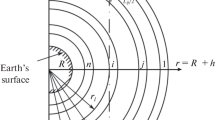Abstract
Collisions between electrons and neutral molecules are of special interest for the physics of the Earth’s ionosphere, in particular, for determining the ionospheric conductivity and current systems in the lower ionosphere of the planet, as well as elucidating the role they play in attenuating radio waves propagating inside the D and E regions of the ionosphere. The effective collision frequency of electrons can be estimated from laboratory studies of electron mobility in atmospheric gases in combination with rocket measurements of temperature and particle density in the Earth’s upper atmosphere, or it can be determined independently from analysis of radio occultation data. We have developed a method for reconstructing the vertical profiles of the absorption coefficient of decimeter (wavelength ~19 cm) radio waves by solving the inverse problem of signal absorption in the D and E regions of the Earth’s ionosphere. Based on the analysis of radio occultation data from the FORMOSAT-3/COSMIC satellites, the altitude profiles of the absorption coefficient of decimeter (DM) radio waves in the planet’s ionosphere during the geomagnetic storm on June 22–23, 2015, were determined. It is known that the absorption coefficient at a given fixed frequency is directly proportional to both the electron density and the collision frequency of electrons with ions and neutrals. Using the data on the vertical profiles of the absorption coefficient of DM radio waves and the electron density reconstructed from the analysis of FORMOSAT-3/COSMIC radio occultations, we estimated the effective collision frequency of electrons in the D and E regions of the Earth’s high-latitude ionosphere. The practical significance of studying the frequency of electron collisions and the effects of radio wave absorption in the D and E regions of the planet’s ionosphere is associated with maintaining the uninterrupted operation of space radio communication and navigation systems.





Similar content being viewed by others
REFERENCES
Gubenko, V.N., Andreev, V.E., Kirillovich, I.A., et al., Radio occultation studies of disturbances in the earth’s ionosphere during a magnetic storm on June 22–23, 2015, Geomagn. Aeron. (Engl. Transl.), 2021, vol. 61, no. 6, pp. 810–818. https://doi.org/10.1134/S0016793221060050
Gubenko, V.N., Andreev, V.E., Kirillovich, I.A., et al., Variations in the parameters of radio waves in the Earth’s high-latitude ionosphere on the satellite–satellite paths during the geomagnetic storm of June 22–23, 2015, Cosmic Res., 2021, vol. 59, no. 3, pp. 157–161. https://doi.org/10.1134/S0010952521030047
Gubenko, V.N., Andreev, V.E., Kirillovich, I.A., et al., The absorption coefficient of decimeter radio waves (∼19 cm) in the Earth’s ionosphere based on the inverse problem solution in radio occultation satellite studies during the June 2015 magnetic storm, Cosmic Res., 2022, vol. 60, no. 6, pp. 437–444. https://doi.org/10.1134/S001095252206003X
Andreev, V.E., Gubenko, V.N., and Kirillovich, I.A., GPS L1 signals absorption in high-latitude lower ionosphere during severe geomagnetic storm in June 2015, J. Phys.: Conf. Ser., 2021, vol. 1991, no. 1, p. 012006. doi 1742-6596/1991/1/012006
Bryunelli, B.E. and Namgaladze, A.A., Fizika ionosfery (Physics of the Ionosphere), Moscow: Nauka, 1988.
Friedrich, M. and Torkar, K.M., Collision frequencies in the high-latitude D-region, J. Atmos. Terr. Phys., 1983, vol. 45, no. 4, pp. 267–271. https://doi.org/10.1016/S0021-9169(83)80048-8
Spencer, E., Patra, S., Andriyas, T., et al., Electron density and electron neutral collision frequency in the ionosphere using plasma impedance probe measurements, J. Geophys. Res., 2008, vol. 113, no. A9, p. A09305. https://doi.org/10.1029/2007JA013004
Gorbunov, M.E., Fizicheskie i matematicheskie printsipy sputnikovogo radiozatmennogo zondirovaniya atmosfery Zemli (Physical and Mathematical Principles of Satellite Radio Occultation Sounding of the Earth’s Atmosphere), Moscow: GEOS, 2019.
Belrose, J.S. and Hewitt, L.W., Variation of collision frequency in the lowest ionosphere with solar activity, Nature, 1964, vol. 202, pp. 267–269.
Belrose, J.S., The lower ionospheric regions, in Physics of the Earth’s Upper Atmosphere, Hines, C.O., Paghis, I., Hartz, T.R., and Fejer, J.A., Eds., Englewood Cliffs, NJ: Prentice-Hall, 1965.
Fejer, J.A., Motions of ionization, in Physics of the Earth’s Upper Atmosphere, Hines, C.O., Paghis, I., Hartz, T.R., and Fejer, J.A., Eds., Englewood Cliffs, NJ: Prentice-Hall, 1965.
Gokov, A.M. and Tyrnov, O.F., Modeling of the electron-molecule collision frequency variations in the undisturbed midlatitude D-region on the experimental basis, 24th Int. Crimean Conf. “Microwave and Telecommunication Technology 2014” (CriMiCo’2014), pp. 1099–1100.
Beharrell, M. and Honary, F., A new method for deducing the effective collision frequency profile in the D-region, J. Geophys. Res., 2008, vol. 113, no. A05, p. A05303. https://doi.org/10.1029/2007JA012650
Funding
This study was carried out in the framework of a state order to the Kotelnikov Institute of Radio Engineering and Electronics, Russian Academy of Sciences.
Author information
Authors and Affiliations
Corresponding author
Ethics declarations
The authors declare that they have no conflicts of interest.
Additional information
Translated by M. Chubarova
Rights and permissions
About this article
Cite this article
Gubenko, V.N., Andreev, V.E., Kirillovich, I.A. et al. Determination of the Effective Collision Frequency of Electrons in the E and D Regions of the High-Latitude Ionosphere from Analysis of Radio Occultation Measurements. Cosmic Res 61, 464–470 (2023). https://doi.org/10.1134/S0010952523700491
Received:
Revised:
Accepted:
Published:
Issue Date:
DOI: https://doi.org/10.1134/S0010952523700491




